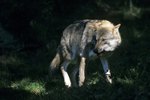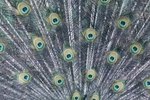
Thirteen creatures are on Utah's Endangered Species list. They include fish, birds, mammals and the Kanab ambersnail mollusk. Conservation efforts are underway in an effort to preserve each of them. The grey wolf, one of many creatures historically found in Utah, is on the brink of becoming de-listed because his reintroduction has been so successful.
Black-Footed Ferret
The black-footed ferret, a member of the weasel family, is the only ferret species native to the United States and the only mammal with habitat in Utah on the Endangered Species list. He is easily identifiable by his black mask that makes him look like a little bandit. The black-footed ferret once roamed 12 American states including Utah, as well as parts of southern Saskatchewan and northern Mexico. Today, only about 1,000 wild ferrets exist, and only in controlled reintroduction areas. The black-footed ferret has been included on the Endangered Species list since 1961, nearly vanishing when farmers and ranchers began wide-scale eliminations of prairie dogs, the ferret's main prey. In 1987, 18 ferrets were captured and became part of a breeding program to reintroduce them into the wild. Each year, 150 to 200 preconditioned black-footed ferrets are released into controlled sites scattered throughout the western United States.
California Condor
The California condor's existence dates back to prehistoric times, and thousands of them once filled the skies over the southwestern United States. Habitat loss, power line accidents and lead poisoning caused the population plummet to just 22 birds. All of the remaining condors were captured and put into breeding programs in southern California zoos. They were reintroduced into the wild in 1991; now more than 330 federally protected birds soar over Arizona, California, Baja California and Utah. California condors are among the largest and rarest birds in North America, growing 4 to 5 feet long and possessing 10-foot wing spans. They can fly between the Grand Canyon and Zion National Park in Utah in a single day, and during summer months seem to favor an area near the Lava Point overlook in Zion. There, up to 20 California condors can be spotted at a time. Since they feed on the carrion of large animals such as deer and elk, lead poisoning from ingested ammunition continues to be the leading cause of death for these condors.
Whooping Crane
The whooping crane population dwindled to just 16 birds as of a 1941 survey. Their primary breeding ground is in Alberta, Canada, and they migrate yearly to the Gulf Coast of Texas at the end of every summer. Today, of a total of 600 whooping cranes, only 200 are living in the wild. A Maryland-based group is reintroducing captive-bred whooping cranes into a Wisconsin habitat. Each year, an ultralight plane guides the young whooping cranes on their first migration south to Florida. The biggest threat to the survival of whooping cranes is the disappearance of wetlands, which provide them with their diet of shellfish, marsh plants, fish, insects and frogs.
Fish
A number of fish found in Utah's rivers and streams are on the federal Endangered Species list. These include the humpback chub, bonytail, Virgin chub, Colorado pikeminnow, woundfin, June sucker, and razorback sucker. These fish are native to either the Colorado River, the Green River or the Virgin River. The biggest threat to their existence is the damming or channeling of rivers, which disrupt fish populations and migration patterns, and destroys breeding grounds. Another major hazard is the introduction of non-native fish, which have preyed upon native fish and spread disease throughout native populations.
References
Photo Credits
-
Photodisc/Photodisc/Getty Images


